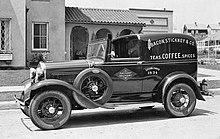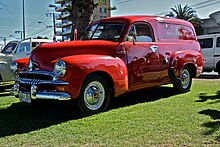Panel van
This article needs additional citations for verification. (June 2012) |

A panel van (or panelvan) is a form of solid (rigid-bodied, non-articulated) van, smaller than a lorry or truck, without rear side windows. In the U.K., this body style is referred to as a "car-derived van", and in American as a "sedan delivery". Panel vans are widely used in many parts of the world for transporting cargo. In some national usages it is distinct from a purpose-designed van in that it is based on the chassis of a family car design. In places where they are distinct from a "van", they have less cargo space but better agility and maneuverability, making them particularly suited for cities with narrow streets or heavy traffic.
History

Tracing their roots back to the early days of automobiles, panel vans have historically been a part of major American car manufacturer's line-ups. Known as a "sedan delivery" in American English, it is a basically a two-door station wagon with sheet-metal panels in place of rear side doors and windows. Sedan deliveries have spartan interior trim and were used by businesses much as cargo vans are used today.
Every major European car manufacturer has a panel van in their line-up [citation needed]; these models used to be modified versions of existing passenger cars, such as the Citroën Visa-based Citroën C15 or the SEAT Ibiza-based SEAT Inca. This format was pioneered from the 1950s by the Citroën 2CV Fourgonnette and the Morris Minor. However, since the introduction of the Citroën Berlingo in 1996, it has become common for these vehicles to have a specific styling and structure, even if they may share chassis, powertrain or other components with passenger cars of the same brand. [citation needed]

In Australia, local panel vans were a development of the Australian "ute" (a variety of pickup also based on a car chassis). Panel vans were also especially popular with younger car buyers in Australia during the 1970s.[1]
Modern versions

Examples of the new wave of panel vans are the Renault Kangoo (1997), the Fiat Doblò (2001), Opel Combo (2001), Ford Transit Connect (2002) or the Volkswagen Caddy (2004). They are also purpose-designed to be utilitarian base model MPVs / people carriers, for a range of such vehicles. Due to economic crisis and strong shift on SUVs and CUVs, only two panel vans which are all-new models being released recently are Dacia Dokker (2012) and Ford Transit Connect (2013).
See also
- Car body style
- Light commercial vehicle
- Panel truck
- Panel van (Australia)
- Pickup truck
- Sedan delivery
